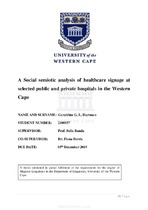| dc.description.abstract | The study focuses on the application and use of linguistic landscapes in health institutions. Furthermore, the research is centred on a social semiotic analysis of the healthcare signage at selected public and private hospitals in the Western Cape with comparisons being drawn between Melomed Private Hospital and Tygerberg Academic (Public) Hospital. Access to healthcare facilities in South Africa is a continuing concern in terms of gaining healthcare information and services. Currently, most research in the area of access to healthcare facilities and information focuses on the limitations and challenges of access to the health services and information in rural areas of South Africa. There is limited research that focuses on the influence spatial material in place and linguistic landscapes have on access to hospital facilities within urban areas, in the Western Cape. The research is an explorative and analytic study of the official or formal as well as unofficial or informal signage at a private hospital (Melomed) and a public hospital (Tygerberg academic hospital) in the Western Cape. The research is based on the tenets of social semiotic theory of multimodality and linguistic landscapes and multilingualism theorems. The conceptual framework of the study includes subtopics such as navigation/way-finding, placement of signage, and language diversity and health signage among others. The data for the research project is of a qualitative nature and, is concerned with understanding the process and the social and cultural contexts which underlie the production and consumption of unofficial and informal signage at a private hospital (Melomed) and a public hospital (Tygerberg academic hospital) in the Western Cape Province. Linguistic Landscapes (LL) utilises signs and symbols to communicate messages to the public. Signage are an expected and common feature within both private and public health institutions and are classified in accordance with the message(s) it intends to convey. These signs and symbols are used to communicate messages or directions to the public in the absence of hospital personnel. During the presentation and analysis of the data, the differences and similarities between Melomed private hospital and Tygerberg academic (public) hospital were looked at. The data presented that Tygerberg academic (public) hospital has a vast amount of informal signs constructed in and around its hospital buildings with a mixture of older and new signs displayed, often next to each other. Therefore, it became evident that Tygerberg hospital does not have a uniformed standard when it comes to its LL. In contrast, Melomed private hospital’s signs are constructed from the same grey metallic materials and are displayed with a singular text format. Furthermore, it was discovered that Melomed only utilise one official business language, English, unlike Tygerberg who strives to use the three official languages, English, Afrikaans and IsiXhosa, prevalent in the Western Cape region. Additionally, Tygerberg academic (public) hospital’s irregular placement of signage demonstrated to be another complex facet. This complexity was partially attributed to its complex structural layout and building design. Melomed’s strategically placed signage, as opposed to Tygerberg, led to the conclusion that the placement of signs, symbols and directories at hospitals can impede or aid the navigation and information provision. The impediment of navigation and information provision can cause visitors, patients and staff extra anxiety which can prolong their arrival at their destination. Moreover, the study concludes that no provisions were made at both Tygerberg and Melomed hospitals to adapt to the recent demographical changes in terms of the influx of migrants and foreign nationals and that the geographical locations of health institutions have a major impact on access to its products and services. | en_US |

